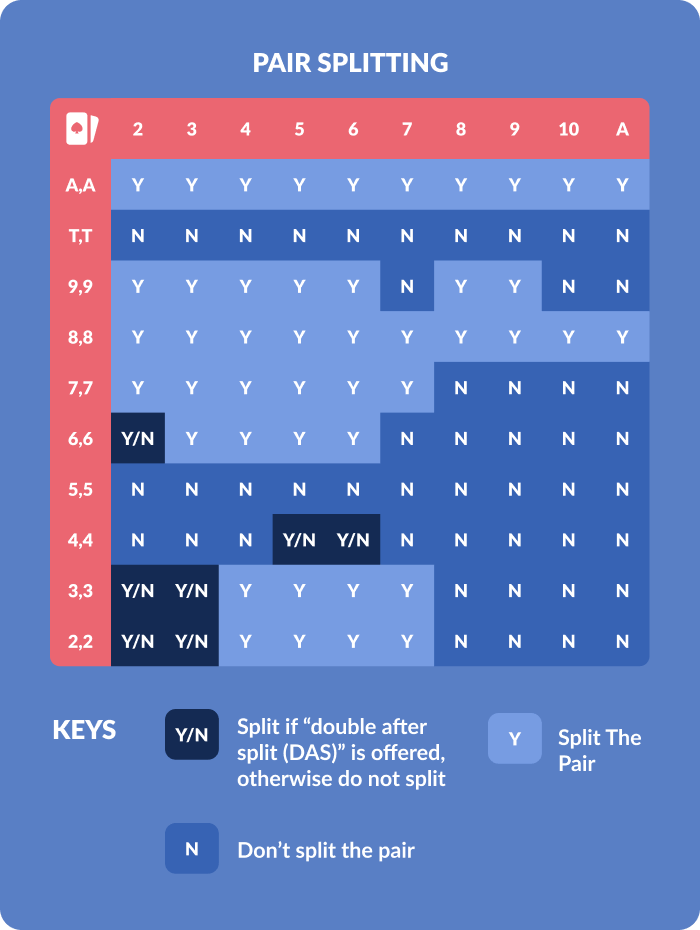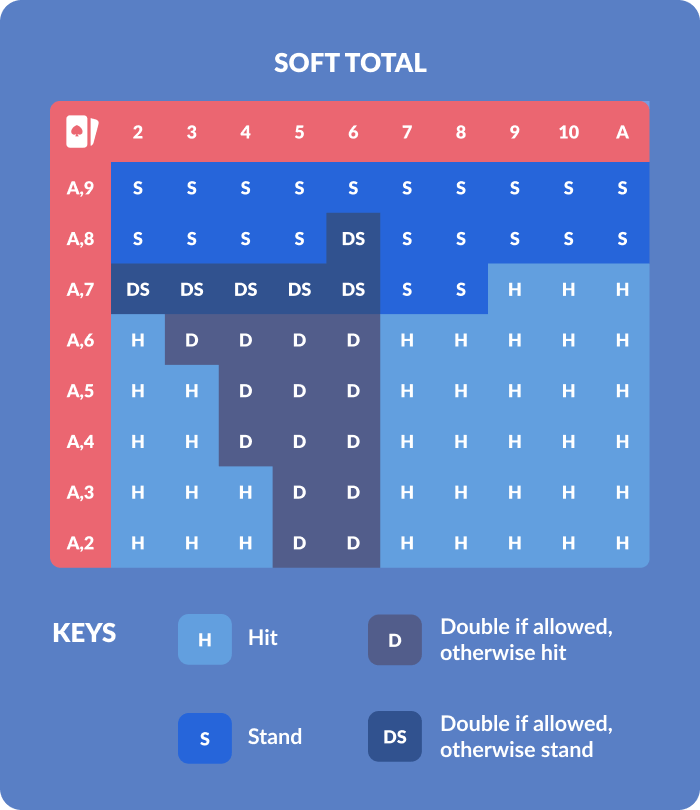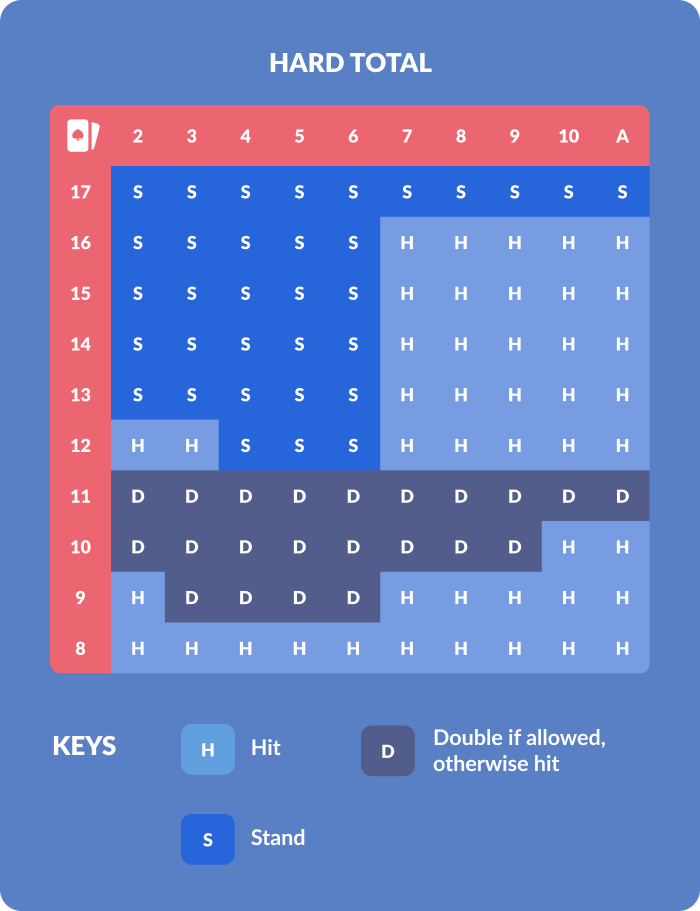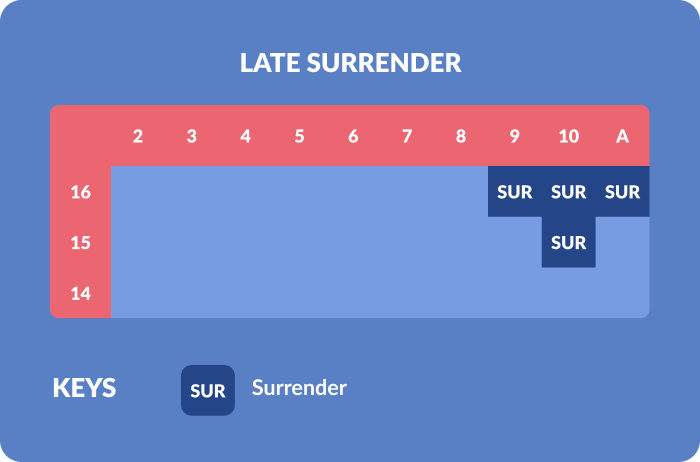Blackjack isn’t just a game of strategy—it’s a battle of decisions. Unlike roulette or slots, where the outcome is purely random, blackjack allows players to make choices that directly affect their odds of winning. When played with a basic blackjack strategy, the house edge can drop to 0.5% or lower, making it one of the best bets in the casino.
This guide breaks down key blackjack decisions—when to surrender, split, double down, hit, or stand—so you can play smarter and win more hands. We’ll also include real-game examples so you can see exactly how these strategies work in action.
Basic Strategy Has An Order Of Operations
- Can/Should you Surrender?
If the casino allows late surrender, you can only do this on your first two cards. If surrender is the correct play, take it; otherwise, move on.
- Can/Should you Split?
You can split if your first two cards are a pair or two ten-valued cards. If splitting is the right move, do it; if not, continue.
- Can/Should you Double Down?
If basic strategy recommends doubling and the casino allows it, double your bet. If not, proceed to the final step.
- Should you hit or stand?
If none of the above options apply, follow basic strategy to determine whether to take another card or stay with your current hand.
Below we will explain each of these circumstances in detail, so you always know exactly what the “Book” says.
When to Surrender
Surrendering in blackjack allows you to fold your hand before playing it out, forfeiting half your bet instead of risking a full loss. Not all online blackjack games offer surrender, so check the rules before playing.
Best Situations to Surrender & Why It Works
Surrendering is a strategic way to minimize losses when the odds are heavily against you. It allows you to forfeit half your bet instead of likely losing the full amount.
- Hard 16 (but not a pair of 8s) vs. Dealer 9, 10, or Ace – One of the worst hands in blackjack; dealer likely makes a strong hand.
- Hard 15 vs. Dealer 10 – The dealer’s 10 gives them a strong advantage, making surrender the best option.
- Hard 17 vs. Dealer Ace (if the dealer hits soft 17) – If the dealer hits soft 17, their odds of improving increase; check specific blackjack rules.
Example
You bet $20 and receive 10♥ and 6♦, while the dealer shows K♠.
- Hitting risks busting (high chance of drawing a 10-value card).
- Standing gives the dealer an easy win.
- Best Move: Surrender and recover $10, rather than playing out a likely losing hand.
When to Split Pairs
If you’re dealt two identical cards, you can split them into two separate hands by placing an additional bet equal to your original wager.
When & Why to Split Pairs
Splitting can turn a weak hand into two strong hands when used correctly.
- Always Split Aces & 8s – Aces give you a good chance at 21; splitting 8s avoids a weak total of 16.
- Never Split 5s & 10s – A pair of 5s is a strong hard 10; 10s already give you a great total.
- Split 2s & 3s vs. Dealer 4-7 (or 2-3 if DAS allowed) – Small pairs are better played separately against weaker dealer cards.
- Split 4s only if DAS allowed and dealer shows a 5 or 6 – Otherwise treat as a hard 8 and hit.
- Split 6s vs. Dealer 3-6 (or 2 if DAS allowed) – Weak dealer upcard makes splitting beneficial.
- Split 7s vs. Dealer 2-7 – Dealer with a weak upcard is more likely to bust.
- Split 9s vs. Dealer 2-6 or 8-9, but NOT 7 or 10-Ace – Keeping 9-9 vs dealer 7 is often better since 18 is strong.
Example
You bet $10 and are dealt 8♦ 8♠. Dealer’s upcard is 6♥.
- Best Move: Split your 8s to create two separate hands and avoid a weak 16.
When to Double Down
Doubling down lets you double your bet in exchange for receiving exactly one more card.
When & Why to Double Down
Double down when the odds heavily favor you—that is, you can improve to a strong hand while the dealer is in a weak position.
- Hard 9 vs. Dealer 3-6 – Good chance of drawing a 10-value card.
- Hard 10 vs. Dealer (not 10 or Ace) – 10 gives a great shot at 20.
- Hard 11 vs. Dealer (not Ace) – Best double-down opportunity; a 10 gives 21.
- Soft 13-14 vs. Dealer 5-6 – Dealer is vulnerable.
- Soft 15-16 vs. Dealer 4-6 – Another dealer-vulnerable spot.
- Soft 17-18 vs. Dealer 3-6 – Dealer likely to bust; doubling yields extra payout.
- Soft 19 vs. Dealer 6 (if dealer hits soft 17) – Can be profitable in that specific rule set.
Example
You bet $10 and receive 5♣ 6♠. Dealer’s upcard is 4♦.
- Best Move: Double down. You place an extra $10 bet and receive Q♣, making 21!
- If dealer busts, you win $40 total ($20 profit).
When to Hit or Stand
Your decision to hit or stand should always factor in the dealer’s upcard. A weak dealer upcard (2–6) means they have a high chance of busting, so stand on marginal hands and let them make mistakes. A strong dealer upcard (7–Ace) pressures you to improve, making hitting more often the correct choice.
- Weak dealer upcard (2–6): Play conservatively and let them bust.
- Strong dealer upcard (7–Ace): Play aggressively and try to improve.
When & Why to Hit
- Always hit hard 11 or less – You cannot bust on the next card.
- Hit hard 12 vs. Dealer 2–3 or 7–Ace; stand vs. 4–6
- Hit hard 13–16 vs. Dealer 7–Ace; stand vs. 2–6
- Always hit soft 17 or less – Soft hands can’t immediately bust.
- Hit soft 18 vs. Dealer 9, 10, or Ace; otherwise stand
When & Why to Stand
- Always stand on hard 17 or more – Risk of busting is too high if you hit.
- Stand on hard 12 vs. Dealer 4–6; otherwise hit
- Stand on hard 13–16 vs. Dealer 2–6; otherwise hit
- Always stand on soft 19 or more
- Stand on soft 18 except hit vs. Dealer 9, 10, or Ace
Example
You bet $10 and receive 10♦ 2♠. Dealer shows 9♣.
- Best Move: Hit. You draw 6♦, making 18—much stronger against the dealer’s 9.
Basic Blackjack Strategy Charts
How to read and use a basic strategy chart for blackjack
Using a basic strategy chart might seem daunting at first, but it’s easier than you think:
- Player Hand: Identify your hand’s total (hard = no ace, soft = with an ace).
- Dealer Upcard: Note the dealer’s face-up card.
- Chart Recommendation: Find the intersection of your hand and the dealer’s upcard on the chart to see whether to hit, stand, double down, or split.
- Repeat: Use the chart for each hand you’re dealt.
The chart takes the guesswork out of your decisions, ensuring you’re making the statistically sound choice for each scenario.




Expert Tips for Using a Basic Blackjack Strategy Chart
Now that you’ve got a good footing on the basics, here are practical tips to keep you on top of the competition.
1. Start with Basic Decisions
Master when to hit and when to stand for common player hands vs. dealer upcards—these core choices will have the biggest impact.
2. Keep a Pocket-Sized Chart
Having a discreet chart at the table or on your desk helps when you’re unsure during play.
3. Practice Online
Playing blackjack online with a chart helps internalise recommendations without risking money; many casinos offer free tables for practice.
4. Avoid Progressive Betting Systems
Systems like the Martingale don’t change the house edge and can quickly deplete bankrolls; focus on strategy rather than betting schemes.
5. Stay Calm and Collected
Emotions can lead to poor decisions. Use the chart to stay disciplined and make rational plays.
6. Review Your Play After Sessions
Assess whether you followed the chart and identify areas for improvement.
7. Learn From Experienced Players
Observe disciplined players: they use the chart consistently and avoid chasing losses.
8. Be Patient and Play Smart
Basic strategy doesn’t guarantee short-term wins but improves long-term decision-making. Stay patient and manage your bankroll.
Popular Betting Systems in Blackjack
| System | How it works | Impact on blackjack odds |
|---|---|---|
| Martingale | The Martingale doubles your bet after every loss so a win recovers previous losses plus a small profit (e.g., $5 → $10 → $20 …). | The house edge is unchanged; table limits and bankroll constraints make long sessions risky and can wipe out funds during long losing streaks. |
| Reverse Martingale (Paroli) | Double bets after wins to capitalise on streaks, revert to original bet after a loss (e.g., $5 → $10 → $20…). | Keeps losses controlled by primarily risking winnings, but streaks are unpredictable and one loss can erase gains. House edge unchanged. |
| D’Alembert | Increase bet by one unit after a loss and decrease by one unit after a win (moderate progression). | Less aggressive than Martingale, slower bankroll depletion; still does not change the house edge and long losing streaks can be costly. |
| Fibonacci | Follow the Fibonacci sequence for bets (1,1,2,3,5,8…). Move forward on losses, step back two places on wins. | Spreads losses more gradually, but like other negative progression systems it requires an eventual win to recover and doesn’t alter house edge. |
| Labouchère | Create a sequence (e.g., 1-2-3-4). Bet the sum of the first and last numbers; if you win cross them off, if you lose add the sum to the sequence. | Customisable risk control but can lead to very large bets after consecutive losses; house edge remains unchanged and table limits may block recovery. |
Conclusion
Blackjack is one of the few casino games where skill makes a real difference. Every decision—surrender, split, double down, hit, or stand—shapes the outcome. By following basic strategy, you’re making calculated moves that give you the best possible odds. The smartest players trust the math, stay disciplined, and manage their bankroll. Stick to the strategy, be patient, and enjoy the game—over time, the right decisions will pay off.
Basic Blackjack Strategy FAQ
Is basic strategy enough to beat blackjack?
Basic strategy minimizes losses but doesn’t eliminate the house edge. To gain a real edge, card counting is required.
Can I count cards in online blackjack?
You cannot count cards in RNG blackjack, but it may be possible in live dealer games where decks and shuffling are more transparent.
What’s the best blackjack strategy for beginners?
Follow basic strategy charts, manage your bankroll, and avoid chasing losses. Practice online to build confidence.
Should I always split Aces and 8s?
Yes. Always split Aces and 8s—Aces maximise chances of 21, and splitting 8s avoids a weak 16.